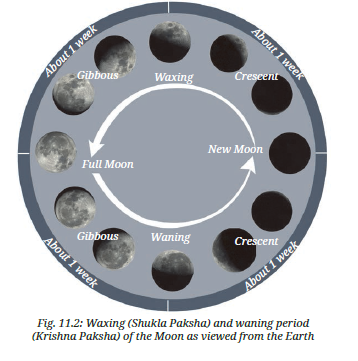Solutions For All Chapters – Science Class 8
Keeping Time with the Skies
Keep the curiosity alive
1. State whether the following statements are True or False.
(i) We can only see that part of the Moon which reflects sunlight towards us.
True
(ii) The shadow of Earth blocks sunlight from reaching the Moon causing phases.
False
(iii) Calendars are based on various astronomical cycles which repeat in a predictable manner.
True
(iv) The Moon can only be seen at night.
False
2. Amol was born on 6th of May on a full Moon day. Does his birthday fall on the full Moon day every year? Explain your answer
Answer:- No, Amol’s birthday will not fall on a full Moon day every year. The lunar calendar, based on the Moon’s phases, has a year of about 354 days, while the Gregorian calendar, used for birthdays, has about 365 days. This 11-day difference causes the full Moon to occur on different dates each year in the Gregorian calendar. So, May 6 will not always align with a full Moon day.
3. Name two things that are incorrect in Fig. 11.10.
Answer:-
In Fig. 11.10, two things that are incorrect are:
1. The Moon is shown with stars behind it, which is not possible as the Moon is much closer to Earth than the stars.
2. The Moon appears to be partially covered by clouds, but clouds do not affect the Moon’s phases; the phases are caused by the changing angles of sunlight reflecting off the Moon.
4. Look at the pictures of the Moon in Fig. 11.11, and answer the following questions.
(i) Write the correct panel number corresponding to the phases of the Moon shown in the pictures above.
Answer:-
| Phase of Moon | Picture label |
|---|---|
| Three days after New Moon | D |
| Full Moon | E |
| Three days after Full Moon | A |
| A week after Full Moon | C |
| Day of New Moon | B |
(ii) List the picture labels of the phases of the Moon that are never seen from Earth. Hint: You can use your observations from Activity 11.1 or Fig. 11.2 as reference.
Answer:-
- Picture B – On a new Moon day, only the non-illuminated side of the Moon faces the Earth, so it is not visible from Earth.
- Picture F – This is not a phase of the Moon. So, it can never be seen from Earth.
5. Malini saw the Moon overhead in the sky at sunset.
(i) Draw the phase of the Moon that Malini saw.
Answer:- At sunset, the Moon is overhead only during the first quarter (a week after New Moon), when the right half is illuminated. So, we need to draw a half Moon (right half bright, left half dark).
(ii) Is the Moon in the waxing or the waning phase?
Answer:- The Moon is in the waxing phase because at sunset a half Moon (first quarter) is seen overhead, and this happens only when the bright part of the Moon is increasing.
6. Ravi said, “I saw a crescent Moon, and it was rising in the East, when the Sun was setting.” Kaushalya said, “Once I saw the gibbous Moon during the afternoon in the East.” Who out of the two is telling the truth?
Answer:- Both Ravi and Kaushalya could be telling the truth, as Ravi is describing a waxing crescent moon visible in the East at sunset, and Kaushalya is describing a waning gibbous moon visible in the East during the day.
7. Scientific studies show that the Moon is getting farther away from the Earth and slower in its revolution. Will luni-solar calendars need an intercalary month more often or less often?
Answer :- Luni-solar calendars will need an intercalary month less often, because as the Moon moves farther away its revolution becomes slower, reducing the difference between the lunar year and the solar year.
8. A total of 37 full Moons happen during 3 years in a solar calendar. Show that at least two of the 37 full moons must happen during the same month of the solar calendar.
Answer :- In 3 years, the solar calendar has only 36 months, but there are 37 full Moons in this period. Since the number of full Moons is greater than the number of months, at least two full Moons must fall in the same month of the solar calendar.
9. On a particular night, Vaishali saw the Moon in the sky from sunset to sunrise. What phase of the Moon would she have noticed?
Answer :- Vaishali would have noticed the Full Moon, because only during the full Moon phase the Moon rises at sunset and sets at sunrise, staying visible throughout the night.
10. If we stopped having leap years, in approximately how many years would the Indian Independence day happen in winter?
Answer :- The Indian Independence Day is on August 15, in summer. Without leap years, the solar calendar would not account for the extra quarter day per year (365.25 – 365 = 0.25 days). Over time, this causes the calendar to lag behind the seasons by about 1 day every 4 years. To shift from summer (August) to winter (e.g., February, about 6 months or 180 days), it would take approximately 180 ÷ 0.25 = 720 years.
11. What is the purpose of launching artificial satellites?
Answer:- Artificial satellites are launched to help with communication, navigation, weather monitoring, disaster management, and scientific research. For example, they can improve maps, plan cities, monitor natural disasters, and study stars and other celestial objects.
12. On which periodic phenomenon are the following measures of time based: (i) day (ii) month (iii) year?
Answer:-
(i) Day: Based on the Earth’s rotation on its axis, which makes the Sun appear to rise and set every 24 hours.
(ii) Month: Based on the Moon’s phase cycle, which takes about 29.5 days to complete.
(iii) Year: Based on the Earth’s revolution around the Sun, which takes about 365.25 days to complete one cycle of seasons.






Leave a Reply